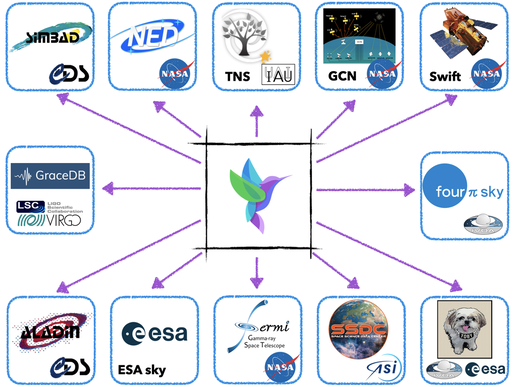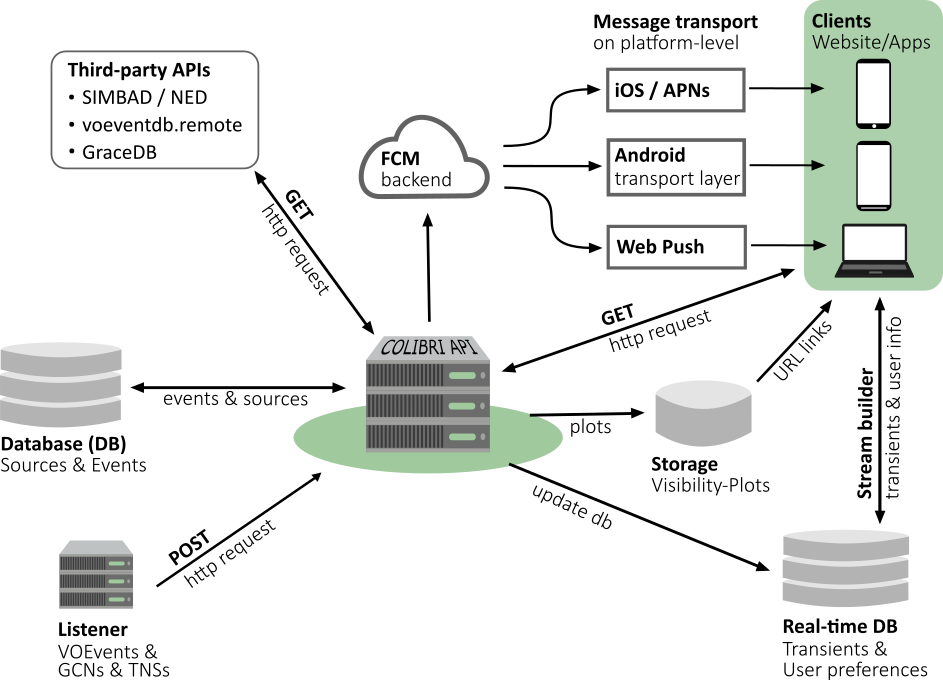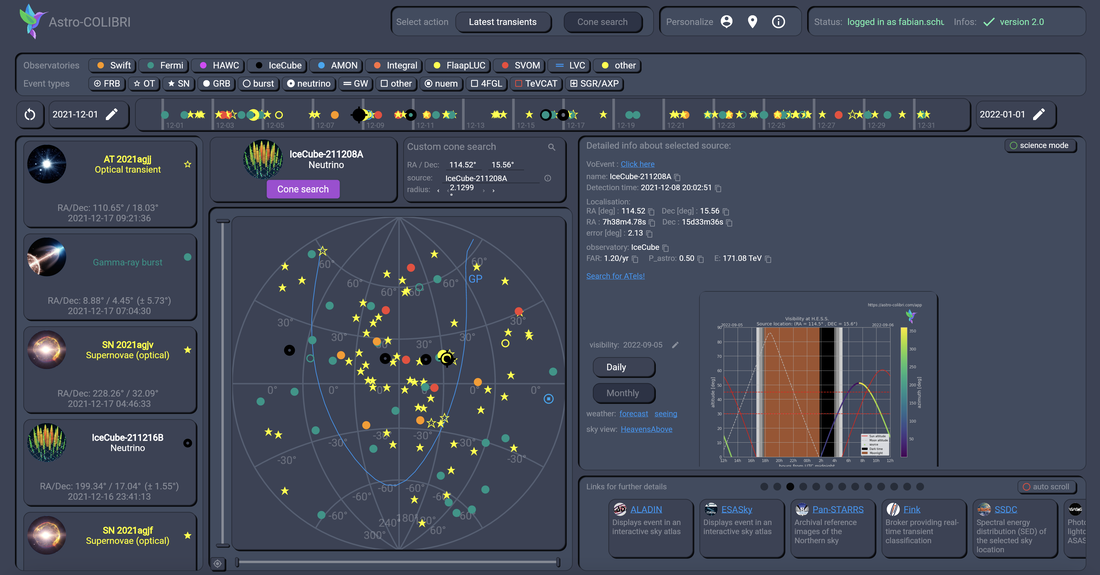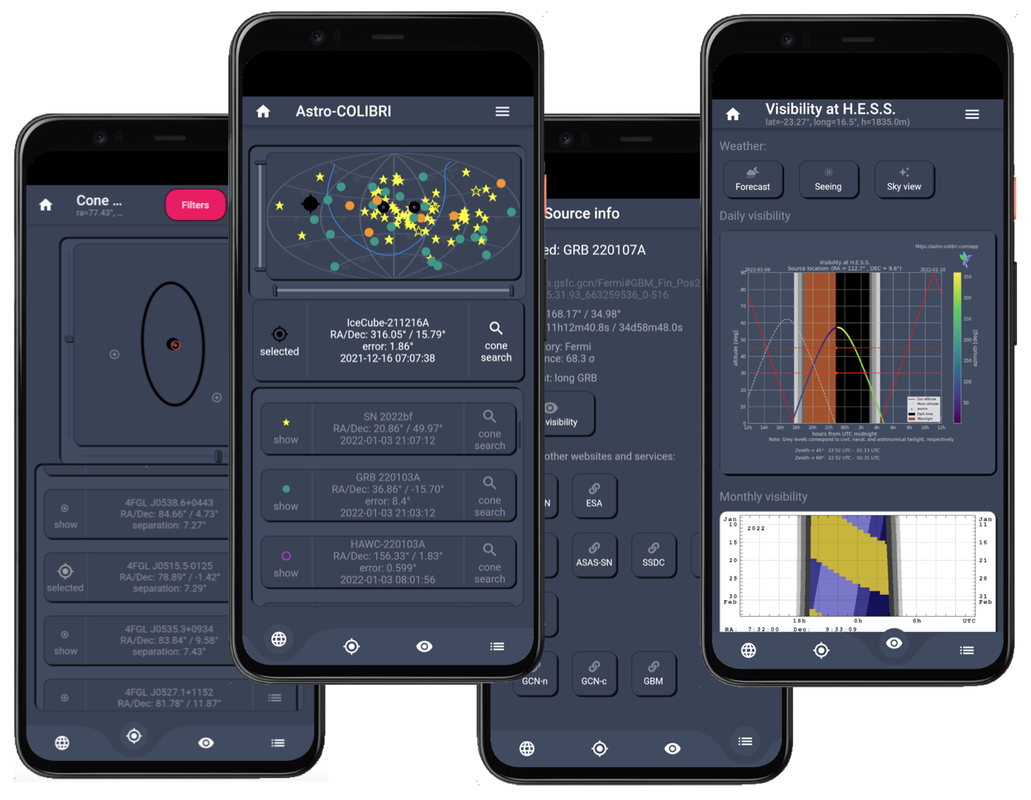
The wealth of information provided by the worldwide network of multi-messenger observatories, combined with the need for reactions in real-time to catch the most violent explosions in the universe requires novel approaches and new tools. In this context we have developed “Astro-COLIBRI”, a platform that evaluates alerts of transient observations in real time, filters them by user-specified criteria, and puts them into their multi-wavelength and multimessenger context. Through fast generation of an overview of persistent sources as well as transient events in the relevant phase space, Astro-COLIBRI contributes to an enhanced discovery potential of both serendipitous and follow-up observations of the transient sky.
The software's architecture comprises an Application Programming Interface (API), both a static and a real-time database, a cloud-based alert system, as well as a website and apps for iOS and Android as clients for users. The latter provides a graphical representation with a summary of the relevant data to allow for the fast identification of interesting phenomena along with an assessment of observing conditions at a large selection of observatories around the world. Providing direct access to a large number of additional and external services, Astro-COLIBRI is a central point of accessing information about astrophysical sources and transient events.
The software's architecture comprises an Application Programming Interface (API), both a static and a real-time database, a cloud-based alert system, as well as a website and apps for iOS and Android as clients for users. The latter provides a graphical representation with a summary of the relevant data to allow for the fast identification of interesting phenomena along with an assessment of observing conditions at a large selection of observatories around the world. Providing direct access to a large number of additional and external services, Astro-COLIBRI is a central point of accessing information about astrophysical sources and transient events.
The challenges of realtime multi-messenger observations require modern solutions. We therefore implemented Astro-COLIBRI in the open source framework Flutter, which allows to provide platform independent and mobile user interfaces. The website is accessible via various URLs (e.g. https://astro-colibri.com and https://astro-colibri.science).
Astro-COLIBRI presents the events in the context of historical data, as well as other transient events under consideration of timescales relevant for the respective event category. For this purpose, Astro-COLIBRI uses cone searches around the event of interest, in which sources and transient events are shown, the latter being filtered for the user-adjustable relevant timescale. An example cone search is presented in the smartphone view in the left image of the figure below. The uncertainty of the localization of the selected transient event is visualized by the boundary matching the color of the marker. In this example, it is the black ellipse.
In multi-wavelength and multimessenger astronomy, there is an increasing demand for rapid and multi-mission coordination for follow-up observations of transient events. Astro-COLIBRI shows the near-term and long-term visibility and observability of transient events of all major observatories or custom locations. The visibility plots contain the monitoring of source altitude, Sun and Moon altitude, Moon phase, Moon-to-source separation if available, etc. In the website and apps, the visibility for the user-selected observatory is shown immediately for the events/source selected by the user. The exact observation conditions, including observations possible during Moon time, are implemented for selected observatories already. The right image of the figure below shows an example of a visibility plot for H.E.S.S. that contains observatory-specific details. Via a customized link to the ESA based Tool for Observation visiBilitY and schedule (TOBY), users also have direct access to the visibility and schedule of space-based observatories like INTEGRAL, Gaia, Chandra, Insight-HXMT, XMM-Newton, and Swift.
Astro-COLIBRI presents the events in the context of historical data, as well as other transient events under consideration of timescales relevant for the respective event category. For this purpose, Astro-COLIBRI uses cone searches around the event of interest, in which sources and transient events are shown, the latter being filtered for the user-adjustable relevant timescale. An example cone search is presented in the smartphone view in the left image of the figure below. The uncertainty of the localization of the selected transient event is visualized by the boundary matching the color of the marker. In this example, it is the black ellipse.
In multi-wavelength and multimessenger astronomy, there is an increasing demand for rapid and multi-mission coordination for follow-up observations of transient events. Astro-COLIBRI shows the near-term and long-term visibility and observability of transient events of all major observatories or custom locations. The visibility plots contain the monitoring of source altitude, Sun and Moon altitude, Moon phase, Moon-to-source separation if available, etc. In the website and apps, the visibility for the user-selected observatory is shown immediately for the events/source selected by the user. The exact observation conditions, including observations possible during Moon time, are implemented for selected observatories already. The right image of the figure below shows an example of a visibility plot for H.E.S.S. that contains observatory-specific details. Via a customized link to the ESA based Tool for Observation visiBilitY and schedule (TOBY), users also have direct access to the visibility and schedule of space-based observatories like INTEGRAL, Gaia, Chandra, Insight-HXMT, XMM-Newton, and Swift.
Astro-COLIBRI is free to use for both professional and amateur astronomers. It is already regularly being using by burst advocates in several observatories (e.g. H.E.S.S., CTA/LST-1, SVOM, etc.). The website is available at https://astro-colibri.com and the smartphone apps can be found in the relevant app stores (Android / iOS). Further information, tutorials, etc. are available on our dedicated YouTube channel. Follow us on Twitter: @AstroColibri and join our open discussion forum: https://forum.astro-colibri.science
A paper describing the functionalities has just been published in the Astrophysical Journal (P. Reichherzer et al 2021 ApJS 256 5, journal link + arXiv). Concrete examples of uses are described in (F. Schüssler et al. PoS (ICRC2021) 935 (2021), arXiv).
A significantly improved version of the web frontend has been released in August 2022. This "Astro-COLIBRI v2.0" is described in a dedicated journal publication that is available here: GALAXIES 2023, 11(1), 22
A paper describing the functionalities has just been published in the Astrophysical Journal (P. Reichherzer et al 2021 ApJS 256 5, journal link + arXiv). Concrete examples of uses are described in (F. Schüssler et al. PoS (ICRC2021) 935 (2021), arXiv).
A significantly improved version of the web frontend has been released in August 2022. This "Astro-COLIBRI v2.0" is described in a dedicated journal publication that is available here: GALAXIES 2023, 11(1), 22



